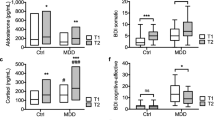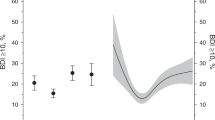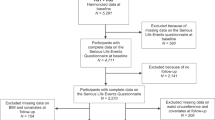Abstract
Depression, stress and diet can all alter inflammation. This double-blind, randomized crossover study addressed the impact of daily stressors and a history of major depressive disorder (MDD) on inflammatory responses to high-fat meals. During two separate 9.5 h admissions, 58 healthy women (38 breast cancer survivors and 20 demographically similar controls), mean age 53.1 years, received either a high saturated fat meal or a high oleic sunflower oil meal. The Daily Inventory of Stressful Events assessed prior day stressors and the Structured Clinical Interview for DSM-IV evaluated MDD. As expected, for a woman with no prior day stressors, C-reactive protein (CRP), serum amyloid A (SAA), intercellular adhesion molecule-1 (sICAM-1) and vascular cell adhesion molecule-1 (sVCAM-1) were higher following the saturated fat meal than the high oleic sunflower oil meal after controlling for pre-meal measures, age, trunk fat and physical activity. But if a woman had prior day stressors, these meal-related differences disappeared—because the stressors heightened CRP, SAA, sICAM-1 and sVCAM-1 responses to the sunflower oil meal, making it look more like the responses to the saturated fat meal. In addition, women with an MDD history had higher post-meal blood pressure responses than those without a similar history. These data show how recent stressors and an MDD history can reverberate through metabolic alterations, promoting inflammatory and atherogenic responses.
This is a preview of subscription content, access via your institution
Access options
Subscribe to this journal
Receive 12 print issues and online access
$259.00 per year
only $21.58 per issue
Buy this article
- Purchase on Springer Link
- Instant access to full article PDF
Prices may be subject to local taxes which are calculated during checkout


Similar content being viewed by others
References
Kiecolt-Glaser JK, Derry HM, Fagundes CP . Inflammation: depression fans the flames and feasts on the heat. Am J Psychiatry 2015; 172: 1075–1091.
Salas-Salvado J, Garcia-Arellano A, Estruch R, Marquez-Sandoval F, Corella D, Fiol M et al. Components of the Mediterranean-type food pattern and serum inflammatory markers among patients at high risk for cardiovascular disease. Eur J Clin Nutr 2008; 62: 651–659.
Martinez-Gonzalez MA, Dominguez LJ, Delgado-Rodriguez M . Olive oil consumption and risk of CHD and/or stroke: a meta-analysis of case-control, cohort and intervention studies. Br J Nutr 2014; 112: 248–259.
Psaltopoulou T, Sergentanis TN, Panagiotakos DB, Sergentanis IN, Kosti R, Scarmeas N . Mediterranean diet, stroke, cognitive impairment, and depression: a meta-analysis. Ann Neurol 2013; 74: 580–591.
Esposito K, Marfella R, Ciotola M, Di Palo C, Giugliano F, Giugliano G et al. Effect of a Mediterranean-style diet on endothelial dysfunction and markers of vascular inflammation in the metabolic syndrome: a randomized trial. JAMA 2004; 292: 1440–1446.
Dai J, Miller AH, Bremner JD, Goldberg J, Jones L, Shallenberger L et al. Adherence to the Mediterranean diet is inversely associated with circulating interleukin-6 among middle-aged men: a twin study. Circulation 2008; 117: 169–175.
Milaneschi Y, Bandinelli S, Penninx BW, Vogelzangs N, Corsi AM, Lauretani F et al. Depressive symptoms and inflammation increase in a prospective study of older adults: a protective effect of a healthy (Mediterranean-style) diet. Mol Psychiatry 2011; 16: 589–590.
Schwingshackl L, Hoffmann G . Mediterranean dietary pattern, inflammation and endothelial function: a systematic review and meta-analysis of intervention trials. Nutr Metab Cardiovasc Dis 2014; 24: 929–939.
Schwingshackl L, Christoph M, Hoffmann G . Effects of olive oil on markers of inflammation and endothelial function—a systematic review and meta-analysis. Nutrients 2015; 7: 7651–7675.
Borsheim E, Kien CL, Pearl WM . Differential effects of dietary intake of palmitic acid and oleic acid on oxygen consumption during and after exercise. Metabolism 2006; 55: 1215–1221.
Pillon NJ, Azizi PM, Li YE, Liu J, Wang C, Chan KL et al. Palmitate-induced inflammatory pathways in human adipose microvascular endothelial cells promote monocyte adhesion and impair insulin transcytosis. Am J Physiol Endocrinol Metab 2015; 309: E35–E44.
Bellido C, Lopez-Miranda J, Blanco-Colio LM, Perez-Martinez P, Muriana FJ, Martin-Ventura JL et al. Butter and walnuts, but not olive oil, elicit postprandial activation of nuclear transcription factor kappab in peripheral blood mononuclear cells from healthy men. Am J Clin Nutr 2004; 80: 1487–1491.
Shikama Y, Aki N, Hata A, Nishimura M, Oyadomari S, Funaki M . Palmitate-stimulated monocytes induce adhesion molecule expression in endothelial cells via IL-1 signaling pathway. J Cell Physiol 2015; 230: 732–742.
Peairs AD, Rankin JW, Lee YW . Effects of acute ingestion of different fats on oxidative stress and inflammation in overweight and obese adults. Nutr J 2011; 10: 122.
Pacheco YM, Lopez S, Bermudez B, Abia R, Villar J, Muriana FJ . A meal rich in oleic acid beneficially modulates postprandial sICAM-1 and sVCAM-1 in normotensive and hypertensive hypertriglyceridemic subjects. J Nutr Biochem 2008; 19: 200–205.
Perez-Martinez P, Moreno-Conde M, Cruz-Teno C, Ruano J, Fuentes F, Delgado-Lista J et al. Dietary fat differentially influences regulatory endothelial function during the postprandial state in patients with metabolic syndrome: from the LIPGENE study. Atherosclerosis 2010; 209: 533–538.
Silvestro A, Brevetti G, Schiano V, Scopacasa F, Chiariello M . Adhesion molecules and cardiovascular risk in peripheral arterial disease—soluble vascular cell adhesion molecule-i improves risk stratification. Thromb Haemost 2005; 93: 559–563.
Ridker PM, Hennekens CH, Roitman-Johnson B, Stampfer MJ, Allen J . Plasma concentration of soluble intercellular adhesion molecule 1 and risks of future myocardial infarction in apparently healthy men. Lancet 1998; 351: 88–92.
Blankenberg S, Barbaux S, Tiret L . Adhesion molecules and atherosclerosis. Atherosclerosis 2003; 170: 191–203.
Hoogeveen RC, Ballantyne CM, Bang H, Heiss G, Duncan BB, Folsom AR et al. Circulating oxidised low-density lipoprotein and intercellular adhesion molecule-1 and risk of type 2 diabetes mellitus: The Atherosclerosis Risk in Communities Study. Diabetologia 2007; 50: 36–42.
Meigs JB, Hu FB, Rifai N, Manson JE . Biomarkers of endothelial dysfunction and risk of type 2 diabetes mellitus. JAMA 2004; 291: 1978–1986.
Song Y, Manson JE, Tinker L, Rifai N, Cook NR, Hu FB et al. Circulating levels of endothelial adhesion molecules and risk of diabetes in an ethnically diverse cohort of women. Diabetes 2007; 56: 1898–1904.
Thorand B, Baumert J, Chambless L, Meisinger C, Kolb H, Doring A et al. Elevated markers of endothelial dysfunction predict type 2 diabetes mellitus in middle-aged men and women from the general population. Arterioscler Thromb Vasc Biol 2006; 26: 398–405.
Chae CU, Lee RT, Rifai N, Ridker PM . Blood pressure and inflammation in apparently healthy men. Hypertension 2001; 38: 399–403.
Rohde LE, Hennekens CH, Ridker PM . Cross-sectional study of soluble intercellular adhesion molecule-1 and cardiovascular risk factors in apparently healthy men. Arterioscler Thromb Vasc Biol 1999; 19: 1595–1599.
Schwingshackl L, Hoffmann G . Monounsaturated fatty acids and risk of cardiovascular disease: synopsis of the evidence available from systematic reviews and meta-analyses. Nutrients 2012; 4: 1989–2007.
Hohmann CD, Cramer H, Michalsen A, Kessler C, Steckhan N, Choi K et al. Effects of high phenolic olive oil on cardiovascular risk factors: a systematic review and meta-analysis. Phytomedicine 2015; 22: 631–640.
Kiecolt-Glaser JK . Stress, food, and inflammation: psychoneuroimmunology and nutrition at the cutting edge. Psychosom Med 2010; 72: 365–369.
Pace TWW, Mletzko TC, Alagbe O, Musselman DL, Nemeroff CB, Miller AH et al. Increased stress-induced inflammatory responses in male patients with major depression and increased early life stress. Am J Psychiatry 2006; 163: 1630–1632.
Bierhaus A, Wolf J, Andrassy M, Rohleder N, Humpert PM, Petrov D et al. A mechanism for converting psychosocial stress into mononuclear cell activation. Proc Natl Acad Sci USA 2003; 100: 1920–1925.
Heinz A, Hermann D, Smolka M, Rieks M, Gräf K-J, Pöhlau D et al. Effects of acute psychological stress on adhesion molecules, interleukins and sex hormones: implications for coronary heart disease. Psychopharmacology (Berl) 2003; 165: 111–117.
von Kanel R, Abbas CC, Begre S, Saner H, Gander ML, Schmid JP . Posttraumatic stress disorder and soluble cellular adhesion molecules at rest and in response to a trauma-specific interview in patients after myocardial infarction. Psychiatry Res 2010; 179: 312–317.
Lesperance F, Frasure-Smith N, Theroux P, Irwin M . The association between major depression and levels of soluble intercellular adhesion molecule 1, interleukin-6, and C-reactive protein in patients with recent acute coronary syndromes. Am J Psychiatry 2004; 161: 271–277.
Rajagopalan S, Brook R, Rubenfire M, Pitt E, Young E, Pitt B . Abnormal brachial artery flow-mediated vasodilation in young adults with major depression. Am J Cardiol 2001; 88: 196–198.
Empana JP, Sykes DH, Luc G, Juhan-Vague I, Arveiler D, Ferrieres J et al. Contributions of depressive mood and circulating inflammatory markers to coronary heart disease in healthy European men—the Prospective Epidemiological Study of Myocardial Infarction (PRIME). Circulation 2005; 111: 2299–2305.
Tchalla AE, Wellenius GA, Sorond FA, Travison TG, Dantoine T, Lipsitz LA . Elevated circulating vascular cell adhesion molecule-1 (sVCAM-1) is associated with concurrent depressive symptoms and cerebral white matter hyperintensities in older adults. BMC Geriatrics 2015; 15: 62.
Dimopoulos N, Piperi C, Salonicioti A, Mitsonis C, Liappas L, Lea RW et al. Elevation of plasma concentration of adhesion molecules in late-life depression. Int J Geriatr Psychiatry 2006; 21: 965–971.
van Sloten TT, Schram MT, Adriaanse MC, Dekker JM, Nijpels G, Teerlink T et al. Endothelial dysfunction is associated with a greater depressive symptom score in a general elderly population: The Hoorn Study. Psychol Med 2014; 44: 1403–1416.
Hammen C . Generation of stress in the course of unipolar depression. J Abnorm Psychol 1991; 100: 555–561.
Husky M, Mazure C, Maciejewski P, Swendsen J . Past depression and gender interact to influence emotional reactivity to daily life stress. Cognit Ther Res 2009; 33: 264–271.
Kiecolt-Glaser JK, Habash DL, Fagundes CP, Andridge R, Peng J, Malarkey WB et al. Daily stressors, past depression, and metabolic responses to high-fat meals: a novel path to obesity. Biol Psychiatry 2015; 77: 653–660.
Kiecolt-Glaser JK, Jaremka L, Andridge R, Peng J, Habash D, Fagundes CP et al. Marital discord, past depression, and metabolic responses to high-fat meals: interpersonal pathways to obesity. Psychoneuroendocrinology 2015; 52: 239–250.
Kennedy AP, Shea JL, Sun G . Comparison of the classification of obesity by BMI vs. Dual-energy x-ray absorptiometry in the Newfoundland population. Obesity 2009; 17: 2094–2099.
Lairon D, Lopez-Miranda J, Williams C . Methodology for studying postprandial lipid metabolism. Eur J Clin Nutr 2007; 61: 1145–1161.
Institute of Medicine Dietary Reference Intakes for Energy, Carbohydrate, Fiber, Fat, Fatty Acids, Cholesterol, Protein and Amino Acids. National Academy Press: Washington, DC, 2002.
First M, Gibbon M, Spitzer R, Williams J . User’s Guide for the Structured Clinical Interview for DSM-IVAxis I Disorders—Research Version. Biometrics Research Department, New York State Psychiatric Institute: New York, NY, 1996.
Almeida DM, Kessler RC . Everyday stressors and gender differences in daily distress. J Pers Soc Psychol 1998; 75: 670–680.
Radloff LS . The CES-D scale: a self-report depression scale for research in the general population. Appl Psych Meas 1977; 1: 385–401.
Stewart AL, Mills KM, King AC, Haskell WL, Gillis D, Ritter PL . Champs physical activity questionnaire for older adults: outcomes for interventions. Med Sci Sports Exerc 2001; 33: 1126–1141.
Harada ND, Chiu V, Stewart AL . An evaluation of three self-report physical activity instruments for older adults. Med Sci Sports Exerc 2001; 33: 962–970.
Kenward MG, Roger JH . Small sample inference for fixed effects from restricted maximum likelihood. Biometrics 1997; 53: 983–997.
Alexopoulos GS, Morimoto SS . The inflammation hypothesis in geriatric depression. Int J Geriatr Psychiatry 2011; 26: 1109–1118.
Juengst SB, Kumar RG, Failla MD, Goyal A, Wagner AK . Acute inflammatory biomarker profiles predict depression risk following moderate to severe traumatic brain injury. J Head Trauma Rehabil 2015; 30: 207–218.
Schaefer M, Horn M, Schmidt F, Schmid-Wendtner MH, Volkenandt M, Ackenheil M et al. Correlation between sICAM-1 and depressive symptoms during adjuvant treatment of melanoma with interferon-alpha. Brain Behav Immun 2004; 18: 555–562.
Thomas AJ, Ferrier IN, Kalaria RN, Davis S, O'Brien JT . Cell adhesion molecule expression in the dorsolateral prefrontal cortex and anterior cingulite cortex in major depression in the elderly. Br J Psychiatry 2002; 181: 129–134.
Thomas AJ, Ferrier IN, Kalaria RN, Woodward SA, Ballard C . Elevation in late-life depression of intercellular adhesion molecule-1 expression in the dorsolateral prefrontal cortex. Am J Psychiatry 2000; 157: 1682–1684.
Sanchez-Villegas A, Delgado-Rodriguez M, Alonso A, Schlatter J, Lahortiga F, Majem LS et al. Association of the Mediterranean dietary pattern with the incidence of depression: The Seguimiento Universidad de Navarra/University of Navarra Follow-up (SUN) cohort. Arch Gen Psychiatry 2009; 66: 1090–1098.
Rienks J, Dobson AJ, Mishra GD . Mediterranean dietary pattern and prevalence and incidence of depressive symptoms in mid-aged women: results from a large community-based prospective study. Eur J Clin Nutr 2013; 67: 75–82.
Meng L, Chen D, Yang Y, Zheng Y, Hui R . Depression increases the risk of hypertension incidence: a meta-analysis of prospective cohort studies. J Hypertens 2012; 30: 842–851.
Pollin TI, Damcott CM, Shen HQ, Ott SH, Shelton J, Horenstein RB et al. A null mutation in human apoc3 confers a favorable plasma lipid profile and apparent cardioprotection. Science 2008; 322: 1702–1705.
Boquist S, Ruotolo G, Tang R, Bjorkegren J, Bond MG, de Faire U et al. Alimentary lipemia, postprandial triglyceride-rich lipoproteins, and common carotid intima-media thickness in healthy, middle-aged men. Circulation 1999; 100: 723–728.
Teno S, Uto Y, Nagashima H, Endoh Y, Iwamoto Y, Omori Y et al. Association of postprandial hypertriglyceridemia and carotid intima/media thickness in patients with type 2 diabetes. Diabetes Care 2000; 23: 1401–1406.
Carney RM, Freedland KE . Depression in patients with coronary heart disease. Am J Med 2008; 121 (Suppl 2): S20–S27.
Nemeroff CB, Goldschmidt-Clermont PJ . Heartache and heartbreak-the link between depression and cardiovascular disease. Nat Rev Cardiol 2012; 9: 526–539.
Shelton RC, Miller AH . Eating ourselves to death (and despair): the contribution of adiposity and inflammation to depression. Prog Neurobiol 2010; 91: 275–299.
Slavich GM, Irwin MR . From stress to inflammation and major depressive disorder: a social signal transduction theory of depression. Psychol Bull 2014; 140: 774–815.
Acknowledgements
The study was supported in part by NIH grants CA154054, CA172296, UL1TRR025755 and CA016058. The sponsor had no role in the design and conduct of the study; collection, management, analysis and interpretation of the data; and preparation, review or approval of the manuscript. We are grateful to Michael Di Gregorio, MA, for his role as a key organizer and experimenter, and to Bryon Laskowski for laboratory analyses.
Author information
Authors and Affiliations
Corresponding author
Ethics declarations
Competing interests
NIH has funded work by JK-G, WBM, CPF and MAB. The remaining authors declare no conflict of interest.
PowerPoint slides
Rights and permissions
About this article
Cite this article
Kiecolt-Glaser, J., Fagundes, C., Andridge, R. et al. Depression, daily stressors and inflammatory responses to high-fat meals: when stress overrides healthier food choices. Mol Psychiatry 22, 476–482 (2017). https://doi.org/10.1038/mp.2016.149
Received:
Revised:
Accepted:
Published:
Issue Date:
DOI: https://doi.org/10.1038/mp.2016.149
This article is cited by
-
The relationship between dairy products intake and breast cancer incidence: a meta-analysis of observational studies
BMC Cancer (2021)
-
The placental lipidome of maternal antenatal depression predicts socio-emotional problems in the offspring
Translational Psychiatry (2021)
-
Psychosocial, behavioral and clinical correlates of children with overweight and obesity
BMC Pediatrics (2020)
-
Multiple lifestyle factors and depressed mood: a cross-sectional and longitudinal analysis of the UK Biobank (N = 84,860)
BMC Medicine (2020)



